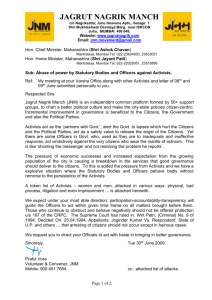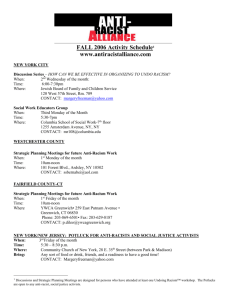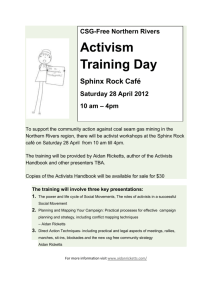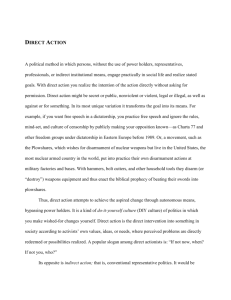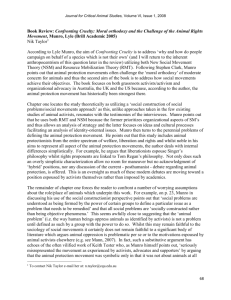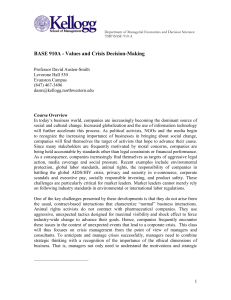UbD Lesson Plan Template
advertisement
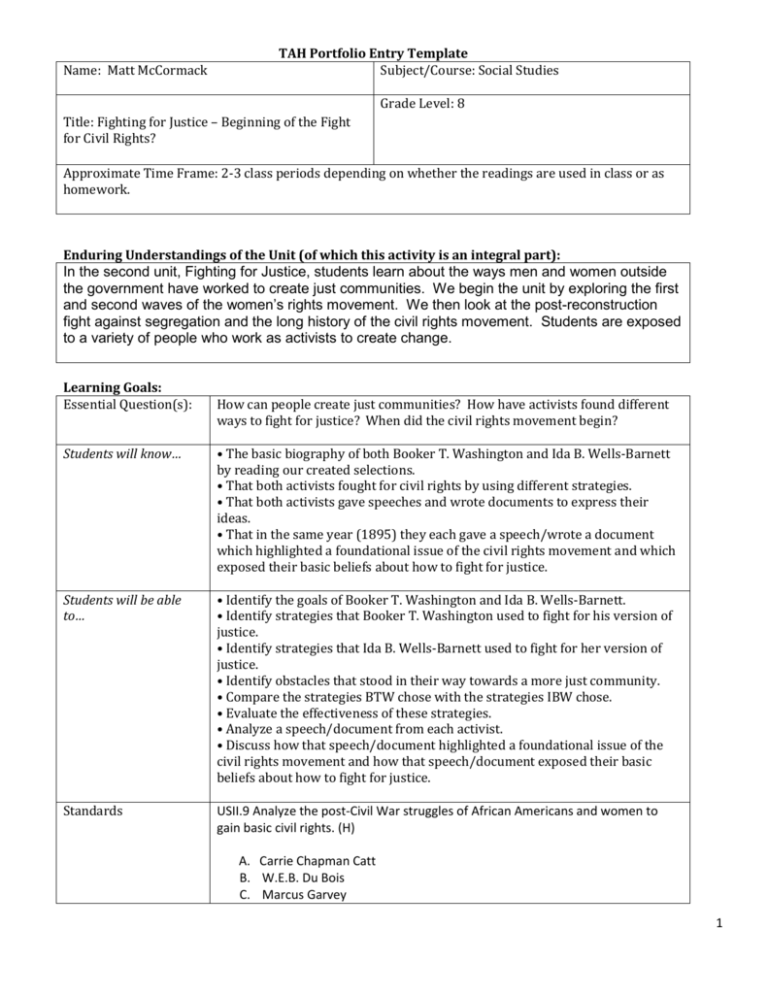
Name: Matt McCormack TAH Portfolio Entry Template Subject/Course: Social Studies Grade Level: 8 Title: Fighting for Justice – Beginning of the Fight for Civil Rights? Approximate Time Frame: 2-3 class periods depending on whether the readings are used in class or as homework. Enduring Understandings of the Unit (of which this activity is an integral part): In the second unit, Fighting for Justice, students learn about the ways men and women outside the government have worked to create just communities. We begin the unit by exploring the first and second waves of the women’s rights movement. We then look at the post-reconstruction fight against segregation and the long history of the civil rights movement. Students are exposed to a variety of people who work as activists to create change. Learning Goals: Essential Question(s): How can people create just communities? How have activists found different ways to fight for justice? When did the civil rights movement begin? Students will know… • The basic biography of both Booker T. Washington and Ida B. Wells-Barnett by reading our created selections. • That both activists fought for civil rights by using different strategies. • That both activists gave speeches and wrote documents to express their ideas. • That in the same year (1895) they each gave a speech/wrote a document which highlighted a foundational issue of the civil rights movement and which exposed their basic beliefs about how to fight for justice. Students will be able to… • Identify the goals of Booker T. Washington and Ida B. Wells-Barnett. • Identify strategies that Booker T. Washington used to fight for his version of justice. • Identify strategies that Ida B. Wells-Barnett used to fight for her version of justice. • Identify obstacles that stood in their way towards a more just community. • Compare the strategies BTW chose with the strategies IBW chose. • Evaluate the effectiveness of these strategies. • Analyze a speech/document from each activist. • Discuss how that speech/document highlighted a foundational issue of the civil rights movement and how that speech/document exposed their basic beliefs about how to fight for justice. Standards USII.9 Analyze the post-Civil War struggles of African Americans and women to gain basic civil rights. (H) A. Carrie Chapman Catt B. W.E.B. Du Bois C. Marcus Garvey 1 D. the National Association for the Advancement of Colored People (NAACP) E. Alice Paul F. Booker T. Washington Seminal Primary Documents to Consider: Booker T. Washington, the Atlanta Exposition Address (1895), and the Niagara Movement Declaration of Principles (1905) Historical Thinking Skills Addressed Standard 2: Historical Comprehension C. Identify the central question(s) the historical narrative addresses. Standard 3: Historical Analysis and Interpretation B. Compare and contrast differing sets of ideas, values, personalities, behaviors, and institutions. E. Compare different stories about an historical figure, era, or event. G. Consider multiple perspectives. H. Explain causes in analyzing historical actions. How will you assess this content/activity? Standard 5: Historical Issues – Analysis and Decision-Making A. Identify problems and dilemmas in the past. D. Propose alternative choices for addressing the problem. F. Identify the solution chosen G. Evaluate the consequences of a decision. ACTIVE READING STRATEGIES USED – I will instruct students to read with a purpose; students will use different symbols to identify strategies and goals of the two activists. I will look at student readings to make sure they have done so. VENN DIAGRAM – In their blue books/student notebook, students will create a Venn Diagram to compare and contrast Washington and Wells-Barnett. Description of Artifact/Rationale: TWO NEW READINGS FOR STUDENTS – I have created two new readings that students will use in conjunction with our second unit, Fighting for Justice. In this unit, students learn about many different activists who try to create communities in which more people (women, African-Americans) have equal rights and opportunities. Students explore a wide variety of strategies that activists employ to achieve their goals. Students evaluate the effectiveness of strategies used by activists to overcome obstacles and achieve goals. Adding Booker T. Washington and Ida B. Wells-Barnett to our unit allows us to pose the question, “When did the Civil Rights Movement start?” more effectively. The problem we were having is that we weren’t exposing students to activists (specifically by name) beyond the traditional people included in 1954-1968. Recently we have added a part to this unit by including the Black Panthers and the Black Power Movement. Doing so, as well as adding these two readings, will help us to expand the scope of the push for civil rights beyond the traditional 1954-1968 time frame. RECOMMMENDATIONS – Teachers should first decide if they will use these readings in class or as homework outside of class. In either case, students should be instructed to actively read the two selections by using a different symbol to mark next to the goals each activist had, strategies each activist used, and obstacles each activist faced. Having the symbols allows students to find and group information easily for any discussion or follow up assignment. Teachers could assign one reading on the first night, and then follow up with processing and discussing in class the next day, along with the primary source selection. Then, teachers could assign the second reading for homework and follow a 2 similar routine the next day. The third day could involve a comparison of the two activists using a Venn diagram and a comparison of the two sources. I would be interested to learn about how teachers could use these resources more creatively. It is my purpose here to provide more resources for our unit as stated above. One way I have utilized biographical information about multiple activists has been to assign students different activists (for example, I used to assign one of eight anti-slavery activist to each student in class). Each student reads a selection and prepares notes based on broad questions all students have (for example, “how did s/he fight against slavery?” “what motivated her/him to fight to end slavery?” etc.). Then I organized a “mock-tail” party in which all students put on name tags (“Hi, my name is… Frederick Douglass”) and pretended they were their activist. Students had to move around the room, with a cup of water or juice – their “mock-tail” – mingling with other activists. Students were required to talk with at least two other activists and learn about them to be able to answer the broader questions in mentioned above. They used gathered information in a small project. Ultimately, each student gained a broader understanding of how various activists fought to end slavery while learning in an interactive manner. PRIMARY SOURCES – I have chosen two primary sources for students to investigate. Washington’s “Atlanta Compromise” speech from 1895 outlines his now-famous plan to help African-Americans advance in society. Essentially, he wants people of color to learn marketable skills in order to prove their worth to the white community and people in power. When they show their value, African-Americans will then gain respect, Washington surmises, which will lead to a gradual gain in civil rights. Wells-Barnett’s “A Red Record” from 1895 uses strong language to challenge people about the brutal reality of lynching. She describes the “excuses” that people have given for lynching to occur and cites the specific “reasons” given for why African-Americans were lynched. The best part of these sources is that I think they are both from 1895. Washington and Wells-Barnett were both leaders to the black community, but were also both criticized. Through reading and comparing these two sources, students will be able to gain a clearer picture of why the two activists were labeled as they were. Students can speculate as to why some people in the black community would have supported Washington and not Wells-Barnett or vice versa. I also think that reading and thinking about the true words of activists brings them to life. It complicates our view of the past by pointing out that both activists wanted change, yet they had different messages, strategies, supporters, and critics both in the black community and in the white community AND they were living and working at the same time. I hope that using these two readings and primary sources would serve to complicate a student’s thinking about the “Civil Rights Movement” while also providing clarity into a struggle in which there were many leaders, many goals, and many strategies used over a very long period of time. Materials/Resources Enclosed Type of Resource(s): Student reading Student reading Primary source Primary source Name of Resource(s): “Booker T. Washington” “Ida B. Wells” “Atlanta Compromise” speech given by B.T.W. 1895 “A Red Record” document written by I.B.W. 1895 3 Tips for other Teachers: Implementation MODERATE VS. RADICAL We have been intrigued with the idea that activists push for progress in many different ways. We have noticed that some activists are labeled during their era based upon the strategies they choose to use and how closely those strategies conform to societal norms. Some are labeled “moderates” like Washington because he did not attempt to take actions that went far beyond what people in power believed were appropriate for black people. Some are labeled “radicals” like WellsBarnett because they take actions that go far beyond these expectations. It is difficult to compare activists from different eras because the expectations for how people act change. Therefore we believed the best method to help students think about strategies for change and how effective these strategies were would be to find activists that were contemporaries. I recommend using “A Red Record” and “Atlanta Compromise” in the same class period. Students will be paired up initially so that each pair gets both primary sources. Students will then get re-grouped based upon the primary source assigned to him/her so that, for example, all students who read “A Red Record” will discuss it together. Then students will go back to their original pairing. This twosome will proceed to share and explain the primary source with each other paying close attention to the language used. Students should talk about who would be branded as a “moderate” and who would be labeled a “radical” and why. Possible REPORT CARD ACTIVITY – see attached sample for Alice Paul Extensions/Modifications Plans for after this lesson/competency is complete: Students will continue in our second unit, Fighting for Justice, by learning about the traditional Civil Rights Movement. This segment of the unit starts with the Brown v. Board of Education decision. We follow the results of the Supreme Court decision in Brown by investigating the many ways that men and women fought for justice in the 1950s and 1960s. We will add the readings on Diane Nash and Angela Davis in this part of the unit as we explore the various strategies activists used throughout the 1960s. 4
